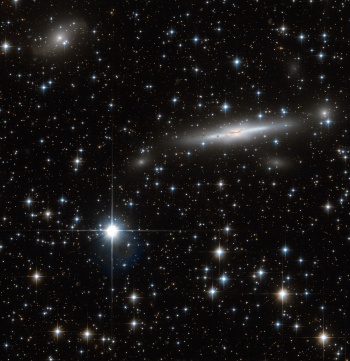The Great Attractor: Difference between revisions
From Star Trek: Theurgy Wiki
Auctor Lucan (talk | contribs) (Created page with "The Great Attractor is an apparent gravitational anomaly in intergalactic space at the center of the local Laniakea Supercluster, in which the Milky Way is located, in the so-...") |
Auctor Lucan (talk | contribs) No edit summary |
||
| Line 1: | Line 1: | ||
The Great Attractor | [[File:Gran_Atractor.jpg|right|thumb|350px|Hubble Telescope image of the region of the sky where the Great Attractor was located.]][[The Great Attractor]] was an apparent gravitational anomaly in intergalactic space at the center of the local Laniakea Supercluster, in which the Milky Way was located, in the so-called Zone of Avoidance that was very difficult to observe in visible wavelengths due to the obscuring effects of our own galactic plane. This anomaly suggested a localized concentration of mass thousands of times more massive than the Milky Way. | ||
The anomaly | The anomaly was observable by its effect on the motion of galaxies and their associated clusters over a region hundreds of millions of light-years across. These galaxies were all redshifted, in accordance with the Hubble Flow, indicating that they were receding relative to the Sol System and to each other, but the variations in their redshift were sufficient to reveal the existence of the anomaly. The variations in their redshifts were known as peculiar velocities, and covered a range from about +700 km/s to −700 km/s, depending on the angular deviation from the direction to [[the Great Attractor]]. | ||
The Great Attractor | [[The Great Attractor]] was moving towards the Shapley Supercluster. In the beginning of the 21st century, astronomical studies by a team of South African astrophysicists revealed a supercluster of galaxies, termed the Vela Supercluster, in [[the Great Attractor]]'s theorized location. | ||
Revision as of 11:33, 11 September 2019
The Great Attractor was an apparent gravitational anomaly in intergalactic space at the center of the local Laniakea Supercluster, in which the Milky Way was located, in the so-called Zone of Avoidance that was very difficult to observe in visible wavelengths due to the obscuring effects of our own galactic plane. This anomaly suggested a localized concentration of mass thousands of times more massive than the Milky Way.
The anomaly was observable by its effect on the motion of galaxies and their associated clusters over a region hundreds of millions of light-years across. These galaxies were all redshifted, in accordance with the Hubble Flow, indicating that they were receding relative to the Sol System and to each other, but the variations in their redshift were sufficient to reveal the existence of the anomaly. The variations in their redshifts were known as peculiar velocities, and covered a range from about +700 km/s to −700 km/s, depending on the angular deviation from the direction to the Great Attractor.
The Great Attractor was moving towards the Shapley Supercluster. In the beginning of the 21st century, astronomical studies by a team of South African astrophysicists revealed a supercluster of galaxies, termed the Vela Supercluster, in the Great Attractor's theorized location.

